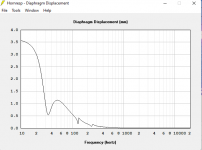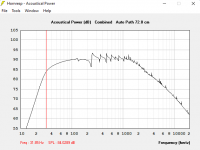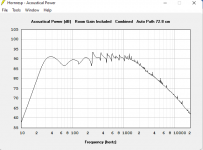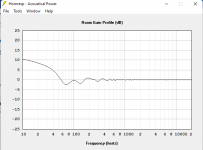I have ordered a box to A CHP-90 now.Bit stuck here on new builds for the CHP-90!
Today I've made a Golden Ratio box for the MAOP 10 and right now I have on my desk both the slotted 14L of the CHP-90 + the same of W5-2143 and on top the old RS-100 hahaTemporary of course (hope so!!!).
I'm almost spending more on clamps than on drivers!!
The sound seems OK but wondering what are the problems of running multiple full ranges together this way, one close to the other in their own enclosure, but with multiple amplifiers...
Technical/physical laws problems? or not? Really newbie on physics of sound!
I did notice that the MAOP they seem to need more "power" then the others but right now of course I'm not pushing the volume at all.
The sound seems really so "clean" btw!
I think that a folded TL would be the best for me for the CHP-90 but I also think I would need some help to do it!
Any practical suggestion on how to proceed?
I've tried hornresp but really too complicate, then try following a vid on YT making some calculation wiht FS / SD (Quarterwave) and for the CHP-90 got a TL of 175cm with a cross section of 17.4 x 4.88cm but not sure if this can be correct and then it has also to be folded and got bit lost...
14 litre 39x24x15cm big.
Please give me yours reaction about 10Maop and TB 2143. Are they better then CHP-90?
Yes. But I use free air 2x. ~89db.Is it ok hornresp simulation for CHP-90
View attachment 1113361
The CHP-90 looks real interesting! I think someone in in this (or another thread) mentioned combing the desirable characteristics of metal and paper cones
For fun, I modelled them in a bipole metronome (two series drivers), and landed on an unusually large (58 l) and low-tuned (34 Hz!) EBS-inspired alignment that looks pretty decent on paper. Looks like diaphragm displacement is controlled pretty well, and the rolloff when blended with some simulated room gain looks like the end results are decently flat. Practical in real life?
Plots are at 1W input power (3.52V into 12.4 ohms for series drivers)
For fun, I modelled them in a bipole metronome (two series drivers), and landed on an unusually large (58 l) and low-tuned (34 Hz!) EBS-inspired alignment that looks pretty decent on paper. Looks like diaphragm displacement is controlled pretty well, and the rolloff when blended with some simulated room gain looks like the end results are decently flat. Practical in real life?
Plots are at 1W input power (3.52V into 12.4 ohms for series drivers)
Attachments
-
 chp_90_bipole_metronome_diaphragm_1w.png6.3 KB · Views: 73
chp_90_bipole_metronome_diaphragm_1w.png6.3 KB · Views: 73 -
 chp_90_bipole_metronome_schematic_1w.png4.4 KB · Views: 72
chp_90_bipole_metronome_schematic_1w.png4.4 KB · Views: 72 -
 chp_90_bipole_metronome_spl_1w.png6.1 KB · Views: 78
chp_90_bipole_metronome_spl_1w.png6.1 KB · Views: 78 -
 chp_90_bipole_metronome_with_room_1w.png6.6 KB · Views: 67
chp_90_bipole_metronome_with_room_1w.png6.6 KB · Views: 67 -
 room_gain.png5.8 KB · Views: 67
room_gain.png5.8 KB · Views: 67 -
chp_90_bipole_metronome.txt2.7 KB · Views: 59
Just two CHP-90 drivers in series (2S configuration in hornresp); practically speaking one forward facing and one rear. Single port at the bottom as usual for a metronome. You can get the same response curve shape by using a single driver, 1/2 cabinet volume, and lengthening the port to match the same fundamental. The end result for this design scaled down to a single driver has less sensitivity and higher excursion; lower power handling capability and more distortion.
Last edited by a moderator:
Well after of chats with members and researching, I bit the bullet and bought a pair of chp90s. I fitted them in my FH3s and they sound lovely. But as good as they are I can't help having the opinion that they are capable of better things, especially with the bottom end.
So more researching, reading and member chats, and I've ordered the materials to build a pair of Markaudio Chp90 Bluebuck enclosures, designed by Scott Lindgren (Scottmoose).
Its a mass loaded TQWT with an FB/F3 of 40Hz, and an F6 of 34Hz. It was the lowest bass design I could find in compact dimensions for the drivers. Will keep you posted.
So more researching, reading and member chats, and I've ordered the materials to build a pair of Markaudio Chp90 Bluebuck enclosures, designed by Scott Lindgren (Scottmoose).
Its a mass loaded TQWT with an FB/F3 of 40Hz, and an F6 of 34Hz. It was the lowest bass design I could find in compact dimensions for the drivers. Will keep you posted.
Last edited by a moderator:
I hope not.  Lagging FH3 with bitumen pads will reduce the designed internal air volume (and alter the horn expansion), and lower panel Fs into the region where the most energy is available to excite it.
Lagging FH3 with bitumen pads will reduce the designed internal air volume (and alter the horn expansion), and lower panel Fs into the region where the most energy is available to excite it.
I assume 'better things' above means 'more LF extension' -FH3 was very specifically not designed for maximum LF extension for reasons set out in the main thread. Tuning is roughly 60Hz - 200Hz, relatively high gain with CHP-90. Bluebuck is an MLTL (not an ML-TQWT as it's an untapered pipe) designed for greater extension in a compact package, albeit with a narrower gain BW.
I assume 'better things' above means 'more LF extension' -FH3 was very specifically not designed for maximum LF extension for reasons set out in the main thread. Tuning is roughly 60Hz - 200Hz, relatively high gain with CHP-90. Bluebuck is an MLTL (not an ML-TQWT as it's an untapered pipe) designed for greater extension in a compact package, albeit with a narrower gain BW.
I assume 'better things' above means 'more LF extension' -FH3 was very specifically not designed for maximum LF extension for reasons set out in the main thread. Tuning is roughly 60Hz - 200Hz, relatively high gain with CHP-90. Bluebuck is an MLTL (not an ML-TQWT as it's an untapered pipe) designed for greater extension in a compact package, albeit with a narrower gain BW.
Exactly. Thanks for the correction and help Scott. Its difficult deciding with designs with no subjective hearing to be had, just specifications painting a picture as what to expect? Especially with material costs the way they are, so bespoke cabinet designs for a specific driver are a massive help for enthusiasts.
No. Never been a fan unless using metal for enclosures. Personally I welcome a small amount of cabinet resonance to add some warmth to the acoustic jazz that I enjoy.Did you try to cover the inside box with bitumen pads to make sure the box itself is not absorbing part of it ? (i just mean sometimes it's not just the box design itself)
Last edited:
No problem. And apologies for the lack of subjective comments from this end -I almost never do, since what I hear (or mean by a given term) is not necessarily how others will interpret it, so there's a good chance it could cause confusion, which is the last thing I want.
As a quick note: none of my designs should have audible panel resonance -assuming bass enclosures, they're done assuming none, with doubled panels and / or indicated or recommended bracing, materials &c. to move panel modes to points where they are unlikely to be excited. Nothing against it if that's what people like (this is a hobby), but it's not how I do things myself.
As a quick note: none of my designs should have audible panel resonance -assuming bass enclosures, they're done assuming none, with doubled panels and / or indicated or recommended bracing, materials &c. to move panel modes to points where they are unlikely to be excited. Nothing against it if that's what people like (this is a hobby), but it's not how I do things myself.
Will you upload any video when you will complete the construction ?Well after of chats with members and researching, I bit the bullet and bought a pair of chp90s. I fitted them in my FH3s and they sound lovely. But as good as they are I can't help having the opinion that they are capable of better things, especially with the bottom end.
So more researching, reading and member chats, and I've ordered the materials to build a pair of Markaudio Chp90 Bluebuck enclosures, designed by Scott Lindgren (Scottmoose).
Its a mass loaded TQWT with an FB/F3 of 40Hz, and an F6 of 34Hz. It was the lowest bass design I could find in compact dimensions for the drivers. Will keep you posted.
Elias
Scott what is the predicted curve response for "Bluebuck" ? By the way I have seen some videos for "Sibelius" speakers. The maker suggests for 33mm thick wood (a French somtning). Did you try with real solid wood ? If yes did you have "better - more detailed" sound ?No problem. And apologies for the lack of subjective comments from this end -I almost never do, since what I hear (or mean by a given term) is not necessarily how others will interpret it, so there's a good chance it could cause confusion, which is the last thing I want.
As a quick note: none of my designs should have audible panel resonance -assuming bass enclosures, they're done assuming none, with doubled panels and / or indicated or recommended bracing, materials &c. to move panel modes to points where they are unlikely to be excited. Nothing against it if that's what people like (this is a hobby), but it's not how I do things myself.
Elias
Elias
The Bluebuck seems good!!! Yes, post updates when you have them!Well after of chats with members and researching, I bit the bullet and bought a pair of chp90s. I fitted them in my FH3s and they sound lovely. But as good as they are I can't help having the opinion that they are capable of better things, especially with the bottom end.
So more researching, reading and member chats, and I've ordered the materials to build a pair of Markaudio Chp90 Bluebuck enclosures, designed by Scott Lindgren (Scottmoose).
Its a mass loaded TQWT with an FB/F3 of 40Hz, and an F6 of 34Hz. It was the lowest bass design I could find in compact dimensions for the drivers. Will keep you posted.
Here in the meantime... not satisfied at all by the CHP-90 and W5-2143 simple build I've done I've just ordered a Behringer ECM8000! to make some measurement and try understand what's wrong and hopefully in some way correct it!
LeifB60 in another thread is trying a simple Golden Ratio BR...
You Elias? Any news?
Last edited:
Yes no problem.Will you upload any video when you will complete the construction ?
Elias
Not yet.Any news?
Elias
Last edited by a moderator:
in which way are you not happy? What simple design are you using?The Bluebuck seems good!!! Yes, post updates when you have them!
Here in the meantime... not satisfied at all by the CHP-90 and W5-2143 simple build I've done I've just ordered a Behringer ECM8000! to make some measurement and try understand what's wrong and hopefully in some way correct it!
LeifB60 in another thread is trying a simple Golden Ratio BR...
You Elias? Any news?
I have them in a simple 14L Bass Reflex (int 18x22x36 cm) and really missing all the low frquencies and the "body"... to me they sound thin and bit shouty, especially when I compared them to the great folded transmission line with the Dayton RS100-4.
I started today learning REW and took some measurement so will post soon some results...
As previously said, maybe they are great but just not my "sound"! or better... still don't have the right box for them!
PS: as I also have the TB W5-2143 and the MAOP10 I'm also changing them in the little larger box of the W5 but even few liters more doesn't seem to change too much. The MAOP btw seems on another level, even if still in break-in period so can't really say...
I started today learning REW and took some measurement so will post soon some results...
As previously said, maybe they are great but just not my "sound"! or better... still don't have the right box for them!
PS: as I also have the TB W5-2143 and the MAOP10 I'm also changing them in the little larger box of the W5 but even few liters more doesn't seem to change too much. The MAOP btw seems on another level, even if still in break-in period so can't really say...
Last edited:
What a shame. I must confess I don't experience that at all in the FH3s. They do produce good and strong bass to a point but then plateau. Scott says the cut off is 60Hz for the FH3 so that explains what I'm hearing. I'm anticipating 20 Hz or so lower with the Bluebucks. Double Bass low `E' is 40Hz. So I guess I was just hearing the harmonics but not the fundamental? Hope this helps.
Last edited by a moderator:
I VERY DOUBT
about the specs claimed from MarkAudio (at least as published in the "datasheet" in SoundImports ). To give you a clue, I measure the diameter of CHP-90 and it is generously 10cm. This gives an Sd = 78,5 cm2 . Not SD 0.0085 m2 -> 85 cm2 ! Lets go further ! In description (I copy-paste)
CHP 90
The CHP90 is an attractive Full-Range multi-purpose drive unit suitable for use in variety of
medium size loudspeakers applications, or as part of a multiway system. For single full-range
point-source purist applications, the CHN90 is highly capable. The cone is formed from paper,
mica and fibreglass materials creating high stability in the emitting surface across the usable
frequency range.
F Zero is 48Hz, VAS is +20 Litres and SPL 89.2 dB. Useable frequency range (depending on box
design) is from 37Hz to 28KHz rated at +89dB in many applications. The frequency response
curve is near flat, making the CHN90 ideal for purist applications. The central mid-range is
benign, near flat response, from 1KHz to 6KHz giving end-users and custom builders the potential
to use the CHP90 as a mid-field driver in larger multiway applications, useful for balancing out
larger radiated surface outputs from big bass units.
The CHP90 also has potential for use in 2 way applications as a bass-mid driver. Most Markaudio
drivers have a purpose designed frequency lift in the lower ranges (typically 100Hz to 500Hz) to
compensate for baffle step losses. The CHP90 is useful to these applications where end-users
and loudspeaker makers need a wider choice on frequency cross-over point selection. The
CHP90 shares the custom, modified-ABS chassis design with the CHR90. All moving parts
(powertrain) are new and custom made for this driver. Much work has been done to make the
CHP90 a versatile driver and extend the well-known performance characteristics of Markaudio’s
products.
©Markaudio Loudspeakers Ltd
F Zero is 48Hz, Yes but at 74dB SPL (-19dB SPL relatively to about 94dB SPL -at 140Hz from the SPL plot).
So I'm asking . Has anyone of you measure the driver himself ? Above (the copy-paste part) there is a weird
mix between CHP_90 and CHN-90. that I don't like it at all .
Elias
about the specs claimed from MarkAudio (at least as published in the "datasheet" in SoundImports ). To give you a clue, I measure the diameter of CHP-90 and it is generously 10cm. This gives an Sd = 78,5 cm2 . Not SD 0.0085 m2 -> 85 cm2 ! Lets go further ! In description (I copy-paste)
CHP 90
The CHP90 is an attractive Full-Range multi-purpose drive unit suitable for use in variety of
medium size loudspeakers applications, or as part of a multiway system. For single full-range
point-source purist applications, the CHN90 is highly capable. The cone is formed from paper,
mica and fibreglass materials creating high stability in the emitting surface across the usable
frequency range.
F Zero is 48Hz, VAS is +20 Litres and SPL 89.2 dB. Useable frequency range (depending on box
design) is from 37Hz to 28KHz rated at +89dB in many applications. The frequency response
curve is near flat, making the CHN90 ideal for purist applications. The central mid-range is
benign, near flat response, from 1KHz to 6KHz giving end-users and custom builders the potential
to use the CHP90 as a mid-field driver in larger multiway applications, useful for balancing out
larger radiated surface outputs from big bass units.
The CHP90 also has potential for use in 2 way applications as a bass-mid driver. Most Markaudio
drivers have a purpose designed frequency lift in the lower ranges (typically 100Hz to 500Hz) to
compensate for baffle step losses. The CHP90 is useful to these applications where end-users
and loudspeaker makers need a wider choice on frequency cross-over point selection. The
CHP90 shares the custom, modified-ABS chassis design with the CHR90. All moving parts
(powertrain) are new and custom made for this driver. Much work has been done to make the
CHP90 a versatile driver and extend the well-known performance characteristics of Markaudio’s
products.
©Markaudio Loudspeakers Ltd
F Zero is 48Hz, Yes but at 74dB SPL (-19dB SPL relatively to about 94dB SPL -at 140Hz from the SPL plot).
So I'm asking . Has anyone of you measure the driver himself ? Above (the copy-paste part) there is a weird
mix between CHP_90 and CHN-90. that I don't like it at all .
Elias
- Home
- Loudspeakers
- Full Range
- MarkAudio CHP-90 Enclosure Options